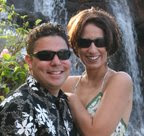To continue on with the last few days theme, I am going to concentrate on the Proprioceptive Sense, as documented in The Out-of-sync Child, by Carol Stock Kranowitz.
"Proprioception tells us about our own movement and body position"
It informs us about where we are in space, how our body parts relate to one another, how much and how quickly our muscles stretch, how fast we are moving through space, how our timing is, and how much force our muscles put forth.
"We get the most and best proprioception when we actively stretch and tighten our muscles in resistive motions, against the pull of gravity" (doing a push-up or doing heavy work like hoisting a loaded laundry basket)
Muscle sensations come through the proprioceptive system, which works closely with the tactile and vesitbular senses (discussed in previous blogs). Proprioception helps integrate touch and movement sensations. Due to the relationship, there are two kinds of processing: Tactile-proprioceptive (judging the weight of a glass of milk or holding a pencil efficiently to write) and Vestibular-proprioceptive (to help throw and catch a ball or climb stairs).
"Another very important function is to help modulate our arousal level".
Proprioceptive experiences calm and organize us. It's these kind of activities that help settle children before they sit to listen to a story. Oftentimes, this is the purpose when someone tells you to stand and stretch for a minute before continuing a lecture or seminar.
Proprioceptive Dysfunction
Proprioceptive dysfunction is the inefficient processing of sensations perceived through the muscles and skin, as well as the joints. (it is almost always accompanied with tactile and/or vestibular problems).
The difficulty in processing the sensations about position and movement of body parts can cause the child to have difficulty using this information for adaptive behavior. Oftentimes, this kind of child is labeled the 'klutz'. Exerting too much or not enough pressure while handling objects is a problem for these children. (breaking pencil points or poor grip on objects or trouble holding two objects of different weights)
To compensate, these children oftentimes needs to use their eyes to see what the body is doing. They need the aid of vision to do things that can normally done by feel. (zipping a jacket, getting out of bed in the dark, orienting body to get dressed)
Overresponsive - avoids stretching and contracting muscles; lacks the 'internal eyes' to see what body parts are doing; shun playground activities; typically picky eaters
Underresponsive- lacks the inner drive to move and play; usually clumsy with toys and materials, may not know they are sitting in an uncomfortable position; may not be able to orient body to get dressed
Seeking - bumper and crasher, active mover; craves passive movement to muscles; may bite, kick, hit and behave in an aggressive manor; oftentimes engaging in self-stimulation, such as biting their own skin or banging head against wall.
Proprioceptive Sense and John
As far as I can tell from the checklists, John again, is a sensory seeker. Many categories here had checkboxes that were not age appropriate for John, as I could not answer one way or another. He is too young to tell if he has low self esteem, lacks self confidence saying "I can't do that", has messy school work, , etc. There are times in his speech that I can tell he 'knows' he can't say the hard E sound. (as in bee, Mommy, please). He is now imitating almost everything we say and if we ask him to say a word with the hard e sound, he all of the sudden won't imitate. So, there might be something there, but again, he seems to young to tell for sure.
Subscribe to:
Post Comments (Atom)




No comments:
Post a Comment